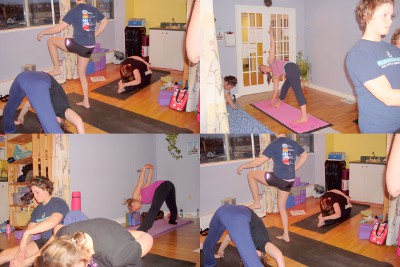This is the second of a four part series of articles about Mysore classes.
Most people that I talk to that have not been to a Mysore class already find the thought of going to one scary. I believe that this is because a Mysore class is new to them and they do not know what a Mysore class is; the benefits of a Mysore class are and the etiquette to follow while in the class.
In the previous article we provided a description of a Mysore class.
In this article we will talk about the benefits of a Mysore style class.
The complete list of articles is:
- Part I – What is a Mysore Class
- Part II – What are the benefits of a Mysore class
- Part III – What is the Etiquette in a Mysore class
- Part IV – Yes but . . .
Part II – What are the benefits of a Mysore class
Flexible start time
Traditionally Pattabhi Jois taught yoga from 5 am until 2 pm and people arrived at class at different times throughout that time period. A Mysore style class in North America is usually offered for 2 – 3 hours either in the early morning or evening.
You pick the start time that works best for you. You may be able to start at the very beginning or you may want to start later. Maybe you are delayed and traffic and will be a little later than usual. This does not matter. Now the stress of getting to class on time is gone. People are expected to arrive when ever they can. This will not be a disruption to the other people in the class. Remember they are doing their own practice and you will be doing yours.
The only important consideration for the start time is to pick a time that permits you to finish your practice before the end of the allotted time for the class.
Your breath – your pace
In a led class you are following the teacher’s guidance for the breath and the movement. There are three possible results to this. One the pace is just right and it matches your natural breath pacing. Or For you the pace may be faster or slower than your natural breath rhythm and you will feel a little awkward.
In a Mysore style practice you follow your own breath. You move at the natural pace of your breath. You are not forced to follow the teacher’s breath count and pace. If someone else is going faster or slower than you that is fine. You follow your own natural breathing rhythm.
If today you want to do a faster paced practice, then that will be entirely up to you. Similarly if you want to move a slower pace, then that is no problem either.
Moving to your breath and setting your own pace will also result in a much hotter practice. You will be breathing at your own natural rhythm and bring in lots of air to heat the body up. The hotter the body gets from the inside out, the more flexible the muscles will become.
Your Practice in a group setting
Most yoga classes are group classes, full of students with all different levels of experience, strength, and flexibility. An instructor leads the class through a series of poses and everyone works on the same poses at the same time. Often, such classes can be too fast or too challenging for beginners and, at the same time, they can be quite easy for advanced students.
In Mysore style classes, students learn and practice Ashtanga Yoga at their own pace. Everyone in the room is practicing Ashtanga Yoga, but they each are working on different parts of the series. For example, beginners may be working on the sun salutations and basic standing poses, while advanced students may be working on back bends and handstands or even the Intermediate series .
Everyone is challenged, without being overwhelmed.
If for some reason you need to do a modified practice or a shorter practice, then you have complete freedom to do so.
You are not locked into what the teacher had planned for the class.
Individual Attention
The teacher works with each student individually and you can spend extra time working on the things that are particularly challenging to you. New poses and transitions are added as flexibility and strength develop, so the practice is always changing and growing. The teacher is not constrained by the need to keep the group moving forward. When you or someone else needs attention the teacher is available to assist. The rest of the people in the room continue on with their own practice at their own pace.
More Intense
Because you move at your pace and to your own breath, you will find that your practice becomes more intense. More heat is generated in the body because you are moving to the natural rhythm of your breath. You are not pausing while the teacher is giving some instructions to the group. You are maintaining your breath, your rhythm and as a result the heat will go up in the body and there will be an increase in flexibility.
Increased Focus
You will find that the mind will become significantly more focused and that the focus will be inward to your practice and your breath. You will lose awareness of the other people in the room. Outside activity will fade from attention. You are alone in the middle of the room doing your own practice. You will not notice people arriving or departing.
Next time
Next time we will talk about the etiquette to follow in a Mysore class.




